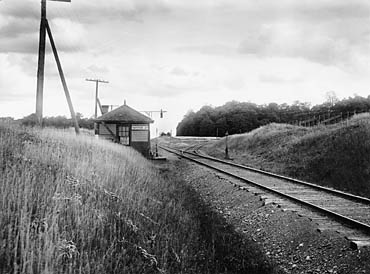| Fact & Fantasy: A History of Tavistock & District | Public Services - Page 55 |
|
|
Rail Traffic Freight trains will still stop in town, but express and telegraph service must all be taken care of through the Stratford Office, on the basis of economy. O quae mutation rerum! How times have changed! Certainly not for the better in our case. In 1896 the train schedule was as follows:
9:02 a.m. Express 11:33 a.m. Express 8:25 a.m. Mixed 4:52 p.m. Mixed 4:52 p.m. Express 9:00 p.m. Express Pt. Dover and Wiarton Line This second line had been constructed in 1876 and served until 1932 when service was discontinued from Hickson to Stratford. Sometimes termed the "peanut line", its rails were of light gauge, suitable only for lighter or yard engines. The tracks were torn up in 1935 and the station sold. The mixed trains were colloquially termed "hog" specials, and quite appropriately, for both Stations of Tavistock shipped carloads and carloads of pigs, cattle, sheep, and lambs to the Toronto and American markets, and cheese and apples as well. John Vance sent a carload of lambs to Buffalo during one week on 1896; R. Moore a carload of sheep to the Old Country, George Matheson a carload of cattle to Boston, the Tavistock Milling Company sent two carloads of flour to Boston, and received a carload of wheat from Goderich. The station, the freight sheds and the cattle chutes were busy places.  TAVISTOCK JUNCTION Main Line with Port Dover tracks entering from the right. The Pt. Dover Line joined the main line at the Junction, about a mile west of the main station. Here Mr. Louis Loth acted as check control for the many trains for 43 years. His son Fred served for many years as agent at the Dover station, where we entrained for the Stratford Collegiate and the Stratford Business College. There used to be the sweetest Tolman Sweets in Mogk's orchard, just across the tracks. Early in the year Mrs. Margaret Philip of Markham was searching for a trace of her grandfather a Mr. Matthew Gibson, who, she claimed, had been the first station-agent here. We have no record of him, but Sutherland's Gazetteer, in 1867 lists Mr. A.M. Kerby as holding that office. The Tavistock Gazette reports a Mr. L. Kuntz in 1902 and a George Reid in 1909. No railway could run without a section gang, a crew to keep the line in shape. Many a time we watched them pump their way over the trails on their "jigger", which they stored in a small shed off the end of Mogk Street: August Walter, Conrad Grein, Arhur Ford, George Berlet and before them Thomas Dryden and William Ruckelshausen, the first section-man to receive a well-earned pension in these parts. For many years Mr. Alex Matheson was in charge of the freight sheds, after traffic proved too heavy for the station-master.  C.N.R. Station and Opera Hall, Tavistock 1940
C.N.R. Station and Opera Hall, Tavistock 1940 |
|
|
| PREVIOUS | TABLE OF CONTENTS | NEXT |